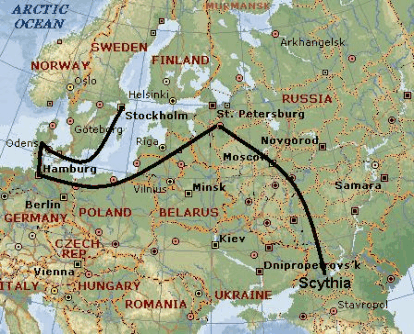
The Oppegaard family
NOTE
The history of the Oppegaard family is more extensive than those of the other families in this
book. The information comes from different sources of varying reliability as might be expected in
an account that goes back to ancient, pre-Christian times.
What we know about the Oppegaards starting with Sigurd Bjørnsen Bonde pa Gulsvik in the 15th
century comes mainly from a history published by Milo Oppegard (sic), a now-retired high school
mathematics and physics teacher in River Falls, Wisconsin. Milo is a grandson of Paul Eriksen
Oppegaard who was the brother of my grandfather John Oppegaard.
Milo writes that his history relies heavily on the research of Erling Bjørke (or Bjerke) for the
material on the family in Norway. Bjørke was, like the Oppegaards, a native of Sokna, Ringerike,
Norway, and was distantly related. He was familiar with the historical archives in Oslo and used
them extensively. He died in 1965.
Milo says the primary recorder of the American portion of the history was his cousin, Roy
Oppegaard, a high school history teacher in Eau Claire, Wisconsin, who was born in 1904 and
died in 1958.
Roy Oppegaard's work eventually found its way to Bert Narveson, a professor of Greek and Latin
at St. Olaf College, Northfield, Minnesota, and a grandson of Paul Eriksen Oppegaard.. He
organized the information and added to it, but was unable to complete the history during his
retirement because of failing eyesight. He passed the material to Milo who produced his book in
1989. It remains the most complete history of that family.
Incidentally, Milo was born in Albert Lea, Minnesota in 1938 when we were living just 25 miles
south in Joice, Iowa. In 2003, he showed me a clipping on the 1935 funeral of his grandmother
Maria reporting that my dad Lodver helped officiate.
We learned more about Oppegaards in the McIntosh, Minnesota, area and about Johannes
Oppegaard in particular from a visit by David M. Scheie with Parnell Oppegaard, my second
cousin.
In 2002 through Milo, I met by e-mail Karen Haukedal of Edmonton, Alberta, Canada, who has
compiled and meticulously documented a mass of data on Oppegaards in Norway and the New
World. Karen’s husband Jerry is a great- grandson of Inger Thorine Oppegaard, a sister of Paul
and Johannes Oppegaard. Karen says she hopes to write a Haukedal-Oppegaard history and I
have encouraged her.
In the spring of 2003, Karen discovered the website http://www.elsrud.com/Slekt/surnames.htm
which traces the family backward in time from Sigurd Bonde to Frøy “Yngve-Frøy” Njordsen or
Ingve Frøysen or Freya Ingvesen or some other variation, born 65 BC. The site is operated by a
Nils Elsrud of Norway. We do not know the sources of Elsrud’s information on Oppegaard
ancestors.
In 2004, Karen discovered another site with a few different names tracing the same line–from
Sigurd Bonde to Frøy Njordsen.
We also found Internet sites which traced Frøy Njordsen’s ancestry back three more
generations: to Yngve or Njord or Niord to Odin to Fridulf, a king of Scythia in central Asia.
One notable site was http://www.stavacademy.co.uk/mimir/moere.htm which showed the
connection cited an 1879 book “History of King Odin: King of Scandinavia” by Albert Welles,
President of the American College for Genealogical Registry and Heraldry.
Welles’ was also the author of a study showing a line from Fridulf and Odin to George
Washington.
A few weeks later we came across the site http://www.genpc.com/gen/gen_files/main.htm
It shows Niord, Odin and Fridulf and then continues back in time 34 more generations–to Jacob
and Isaac of the Old Testament, with extensive footnotes to most entries. The author does not
give his name but offers the disclaimer: “all of these files are a WORK in PROGRESS not all have
been personally verified by me.”
So, how do we regard all this?
I feel very confident of Erling Bjørke’s material covering the period since Sigurd Bonde pa
Gulsvik in the 15th century.
However, during the 14th and 15th century, when the Black Death was the pandemic throughout
Europe, including Scandinavia, the collection of data became less important and therefore less
accurate. So the link between Sigurd Bjørnsen Bonde pa Gulsvik back to Harald Harfagre, born
865, is open to question.
The lineage from Harald Harfagre to Frøy Niordsen is described in depth by Snorri Sturluson
(c.1179-1241) in the Heimskringla, a history of the Norse kings of the first millenium, and in other
sagas. It is understandable that records of the royal family would have been preserved, but it is
not so clear where history leaves off and mythology begins. I am still trying to determine how
historians view these sagas.
The line from Isaac and Jacob to Fridulf, Odin, Niord and Froy seems to have been recorded in
several places, hence all the footnotes, but I can’t vouch for their accuracy.
Then, of course, just one generation back from Isaac is Abraham and ancestors back to Adam.
Abraham is believed to have lived in the second millennium B. C. but most scholars say Biblical
dating before that is questionable.
With those caveats, here is the story as we now understand it.
David L. Scheie
Cedar Rapids, Iowa
October, 2004
The Oppegaard family
The family may date from Biblical times. From the Old Testament we are familiar with the first
three names on the list. But at the moment, at least, we know little about the next succeeding
generations. So, for now, we merely list names:
Isaac. Spouse: Rebekah
Jacob. Spouse: Leah
Judah: Spouse: Tamar
Zara (Zarah). Spouse: Electra (One of the Pleiades)
Dardanus Darda. Spouse: Batea Asia Ilium
Erichthonius. Spouse: Astvocho Ilium
Tros (Troy)
Ilus
Laomedon
Priam (King of Troy)
Daughter of Priam. Spouse: Memnon
Thor (Tror)
Vingener
Hloritha
Eiardi
Vingethorr
Vingener
Moda
Magi
Seskef
Bedweg
Hwala
Hathra (Athra)
Itormann
Heremod
Scelda (Sceaf)
Scealdea
Beowa
Taewa (Tecti)
Geata
Godwulf
Flocwald
Finn
Freothelaf
Freothelaf’s son was Fridulf and from here on we have some details, not just a list. Fridulf was
the Supreme Ruler of the Scythians in Asaland or Asaheim or Asgard in what today is Turkestan,
between the Euxine and Caspian Seas, in central Asia. We do not know the date of his birth but it
was probably before 150 BC.
Fridulf had at least three sons; the first was given the name Sigge, but later took the name of Odin
which was the name of the Scythians’ god.. Odin (the man), thus became the High Priest and
symbol of his people’s religion, perhaps the personification of the god himself. He was also
known as a great warrior, one who never lost a battle, and was loved by his subjects. One writer
has called him both the Mars and Mohammad of the Asen or Aesir or people of Asgard.

Pressured by the invading Romans
led by Pompey, Odin left Asgard in
the hands of his two brothers and headed northward with his pontiffs
(religious sub-leaders) and many
followers. They passed through
Gardarike or Russia to Saxland,
subduing tribes and nations in their
path.
About 70 BC, he reached the Baltic
and crossed into present day
Denmark to the island now called
Fyn, then called Fionia. There he
made his residence, declared himself
King of Denmark and is said to have
established the city of Odense.
Seeking to extend his rule, Odin passed over to Sweden, then ruled by a prince Gylfe. Odin built
a home at Lake Logur (Malaren) near Stockholm. He also erected a splendid temple at Sigtuna for
celebrating the rites of his religion.
The surrounding territory, which formed the core of Odin’s empire, became known as Lesser Svitjod or
Sweden, in contrast to Greater Svitjod or Scythia from which he had come. Sometimes it was referred to
as Mannheim, the home of man, to distinguish it from Asgard or Godheim, the abode of the Asen or
Aesir or celestial deities.
The pontiffs took up residence in Uppsala and other neighboring districts.
Before his death about 55 BC, Odin divided Scandinavia into five more-or-less equal parts and
made his five sons the temporal and religious rulers of each.
Heimdall became king of Scania, in what is now southern Sweden..
Seming or Suabone ruled in Norway. From him descended a line of Pontiff Kings whose names,
but not deeds, were recorded.
Skiold was king in Zealand and founded the Danish royal family. Other descendants became the Capetian
royal family of France and another was George Washington, our first president.
Balder was appointed Viceroy of the Angles in Lower Holstein and became the progenitor of the
Anglo-Saxon kings and princes.
Yngve or Niord, the second son and our possible ancestor, reigned in Svitjod or Sweden north of
Scania and from him come the Ynglings, the name of the Swedish and Norwegian royal family.
Their history is recorded in the "The Yngling Saga" of Heimskringla and The Saga of the Norse
Kings, by Snorri Sturleson and elsewhere. It is not clear how much of the Sagas is myth and how
much is factual.
Yngve (or Niord) died about 20 BC.
There are many variations of Old Norse names. Many would apparently sound
the same but have different spellings. Sometimes “sen” and “son” and “sonn”
and other variations are used to mean son. Sometimes the order in multiple
names is scrambled.
Yngve’s son was Frøy Ingvesen or Frey-Yngve or Ingve Frey Njordsen who was born in 65 BC
and died in 10 BC..
Frøy succeeded his father as King of Svitjod and probably lived in Uppsala. He was married to
Gerd Gymnesdatter.
Their son was Fjalne (or Fjolnir or Fiolner) Froysen, born in 32 BC and died in 14 AD in Sweden. He had
a son Svegde Fjalnesen, born in 1 BC.
The Saga tells the story of Fjalne’s visit to Frode, King of Denmark, his second cousin.. Frode prepared a
great feast in Fjalne’s honor and invited many guests from throughout the country.
A large vat was put into the floor in which strong alcoholic mead was prepared. Fjalne and his party had
rooms in a gallery above the vat.
During the night, Fjalne felt “nature’s call” and, very drunk and sleepy, left his room to relieve himself.
Returning, he slipped, fell from the gallery into the vat of mead–and drowned.
Svegde succeeded Fjalne as King of Svitjod as well as of a place in Russia where his wife, Vana,
came from.
According to the Saga, Svegde and his men had been drinking excessively one night. They were about to
retire when Svegde looked outside the house and saw a large stone with a dwarf sitting under it. He
rushed out to the stone. The dwarf opened a door and urged Svegde to come inside so he could see
Odin. Svegde entered, but never came out.
His death occurred in 34 AD.
Svegde and Vana had a son Vanlande (or Vinlande or Vinlandi) who followed him as King of Sweden.
He spent a winter in Finland where he met and married Driva, daughter of Snow the Old.
When spring came, Vanlande returned to Sweden, but left Driva behind after promising to return
within three years.
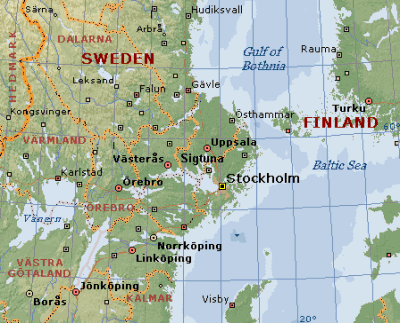
After some months, Driva had a son,
Visbur. Ten years later, she sent
Visbur to ask his father to
return. She also hired a witch named
Huld to either bewitch him into
returning or to kill him.
While pondering options presented
by Huld, Vanlande had a
“nightmare” and was reported
trampled to death by a Mara, a
female ghost. The date of his death is
not known.
Visbur Vanlandsen then became
King of Sweden. He married a
daughter of Aude the Rich and
they had two sons, one of whom was
named Domalde, born about 110.
But after a time, Visbur
sent his wife and sons away so he
could marry another woman.
The wife sent the boys back to Visbur demanding he return her dowry–three large farms and a
gold ornament–but Visbur refused.
During the night, the sons and a group of their men burned down Visbur’s house with him in it.
Part of the dowry figured in later events.
Domalde succeeded his father as King of Sweden at a very bad time--when the country was
ravaged by drought and famine. Sacrifices to the gods did not bring rain. After three years, a great
number of people gathered in Uppsala and decided Domalde was the one the gods were angry
with and therefore they must sacrifice him, which they did in 130.
Once this was done, rains came, good crops returned and the people lived in peace and plenty..
Domalde’s son was Domar Domaldesen who reigned as King of Sweden from 130 until his death
in 162. His reign was peaceful and long.
He married Drott Danpsdatter, whose father was King Danp and whose brother was King Dan Mikkillati,
after whom Denmark was named.
Domar and Drott’s son was Dygve (or Drygve) Domarsen. His reign, too, was peaceful and he
died in his bed in 190.
His son was Dag Dygevesen sometimes called Dag-Spaka or Dag the Wise who was king from 190 to
220.
The Saga reports Dag had a special gift: he could communicate with birds. He owned a sparrow
which he would send to other countries to spy for him.
On a trip to Reidgotaland, the sparrow was killed by a peasant. When Dag heard of this, he
plundered the country in vengeance, killing many people.
While walking back to his ship for the voyage home, a peasant threw a hay fork at Dag riding
with a group of his men, hitting him in the head and killing him.
Up to this point, various sources generally agree on the dates for the kings’
births, reigns and deaths. But from here on until the tenth century, they tend to
disagree widely. The dates which follow seem to be most reasonable.
Dag’s son was Agne Dagssen who became king in 220.
One summer, he took an army to Finland where he defeated and killed the chieftain Froste and
captured his son Loge and daughter Skjalv. On the way home, he married Skjalv who persuaded
him to hold a great burial feast in honor of her father.
Dag became very drunk at the feast and fell into a stupor while wearing around his neck the gold
ornament that his great-great-great-grandfather Visbur had refused to hand over to his wife when
she demanded return of her dowry.
Skjalv fastened a noose around Dag’s neck under the ornament while he slept and, with the help
of her men, threw the rope over a tree branch and hanged him.
Dag’s son was Alrik (or Alrek) Agnesen who was born in 240 and became King in 260. He
married Dageid Dagsdatter and had two sons, Yngve and Alf.
One day in 280, Dag and his brother Erik rode out into the fields and did not return. In time, their
bodies were found with their heads crushed. However, neither had a weapon.
The official conclusion was that they had used the bridles of their horses to beat each other to
death.
Yngve Alrikssen became King of Svitjod in 280, on the death of his father. His brother Alf
became king of some lesser kingdom and was very jealous of Yngve. Alf’s wife fueled his jealousy
by demeaning him and by flattering Yngve and openly preferring his company.
One night Yngve and his wife were at a party that turned into a drinking orgy. The guests were
said to be so intoxicated they did not see Alf enter the room, approach the high seat where Yngve
sat and stab him. Yngve reacted by stabbing Alf and both fell dead
Yngve was succeeded by his son Jorund Yngveson who became King in Uppsala in 302. Jorund
went on many plundering expeditions, but they ended suddenly when he was captured in Denmark
and hanged in 312.
His son Aun hinn Gamle (Aun the Old) Jorundsen, born about 360, became king. He was not a
warrior but stayed “quietly at home.” He fled from invaders several times, but returned when they
left..
Aun wanted to live a long life and to encourage the gods to let him do so, he sacrificed nine of his
sons. He sought to sacrifice the tenth, but the people of Sweden refused to allow it. Aun died
peacefully in 448 at the age of about 88 and after a reign of 68 years.
The son who succeeded him was Egil Tunnadolgi Aunesen, born about 400, who, like his father,
preferred staying home to fighting. But he was forced to fight when other kingdoms attacked him
and eventually he was forced to flee to Denmark. There, he enlisted an army which helped him
regain his land and authority.
But, three years later, back in Sweden, Egil was gored by a bull and died. He is buried in a mound
at Uppsala.
Egil’s son Ottar Egilsen Vendelcrow, born about 440, became King of Svitjod but got on the outs
with Denmark’s King Frode.
In 460, Frode attacked, killed Ottar in a battle and left his body for the ravens and wild animals.
Succeeding him was his son Adils Ottarsen. who ruled Svitjod for 45 years. Adils went on many
Viking expeditions and became very rich.
On one voyage, Adils and his men plundered a king’s house on the coast of Holstein. They also
captured a large herd of cattle and the people tending the herd. Among them was an attractive girl
named Yrsa who became Adils’ wife.
Adils died in 505 when his horse stumbled and threw him so his head struck a stone.
Adils and Yrsa had a son, Oystein Adilsen, who was King of Sweden from 505 to 531. His reign
ended when a marauding sea king named Solve came upon the house in which Oystein, his family
and court were sleeping and set it afire. All inside were killed.
Oystein’s son Yngvar Oysteinsen ruled Sweden from 531 to 545 when he was killed in a battle
with the Baltic nation of Estland.
His son Onund Braut Yngvarsen “Roadbuilder” succeeded to the throne and was one Svitjod’s
most loved kings. He cleared land and brought it into cultivation, and, as his name suggests, built
roads.. In 565 Onund and a party of people were passing through a deep, narrow valley after
heavy rains had fallen when a landslide buried them all.
He was followed by a different sort, his son Ingjald Illraade “The Untrusty” or “The Evil” Onundsen.
Ingjald was King of Sweden from 565 to 623. He reportedly was fed the roasted heart of a wolf
when he was a young boy and thereupon became ferocious and ill-tempered.
On one occasion, he invited many of Sweden’s important leaders, including six kings, to his house
for a feast. When the guests became adequately drunk, Ingjald and his men set fire to the house,
killing all those inside.
He did this several times. On the last occasion in 623, when he found himself facing defeat, he and
his men got drunk in a house, set it on fire and all died.
Ingjald’s wife was Gauchild and their son who succeeded him as King of Sweden was Olav Tretelja
(“Tree Heaver” or “Tree Feller”) Ingjaldsen.
After his father’s death, Olav fled to Varmland and married Solveig, the daughter of Halvdan Guldtand.
His reign ended when famine struck the land and the people set fire to Olav’s house as
he slept in an effort to appease the gods.
He was succeeded as King of Sweden by his son Halvdan Olavsen Hvitbein (“White Legs”).
Halvdan was brought up by his uncle Solve, his mother’s brother, and became King of Denmark
about 710.
Some of the Swedes, meanwhile, had decided they had been wrong to blame Halvdan’s father
Olav for the famine; the real problem was over-population. So they sent an army against Solve,
killed him, brought Halvdan back to Sweden as a prisoner then made him king.
Eventually, he became a great king in Vestfold, in what is now southeastern Norway. There he
married Åse of Oppland, the daughter of Oystein the Severe, King of Oppland and Hedmark
(where the Scheies and Myklebys, respectively, came from).
Halvdan lived peacefully and died in his bed as an old man in 740.
Halvdan and Åse’s son was Oystein Halvdansen Freet, born in 710, who married Hild Eriksdatter,
the daughter of King Erik Agnarsen.
Oystein’s reign ended on the return voyage from a Viking raid when he drowned after being hit by
a boom from another ship and knocked into the water.
Oystein and Hild had a son, Halvdan Eysteinsen Milde (“The Gentle” or “The Mild”) born in 760..
He was also called “Bad Entertainer” because he did not feed his men well.
Halvdan married Liv, the daughter of King Dag of Vestmare, and became King of Vestfold in
about 780.
He and Liv lived at the Holte farm and had at least two sons: Oystein and Gudrod. Oystein died in
802.
So the crown passed to the second son, born about 790, who became known as Gudrod Den Gjeve
Halvdansen Veidekonge (“The Noble King” or “The Hunter” or “The Magnificient”).
Gudrod became king of Vestfold and Romerike. His first wife was Alhvilde who died soon after
their marriage.
Gudrod then sent a delegation to Harald Granraude (Red Beard), the King of Agder to ask for the
hand of his daughter Åse. But Harald refused.
When the delegation reported back to Gudrod, he launched a large fleet of ships and slipped into Agder
undetected. Harold fought back but was outnumbered. He and his son Gyrd were both
killed in the battle. Gudrod seized Åse, as well as a large amount of loot, and returned to Vestfold
where they married and soon had a son, Halvdan.
In 821, when Halvdan was about a year old, Gudrod left on a party-tour. At Stivlesund, he got
very drunk. When he tried to go ashore, a man rushed at him on the gangway and ran him through
with a spear. The attacker was killed and identified as wife Åse’s footman. She made no effort to rebut
charges that she planned the attack.
Åse then took over as Queen of Vestfold and Romerike and immediately set off westward with
one-year old son Halvdan to her home kingdom of Agder where she also took the throne formerly
held by her father Harald Granraude.
When Åse died, she is believed to have been buried in the Oseberg Viking Ship,
excavated in 1904. Another Viking ship buried at Godstad is believed to have held
the body of Halvdan’s half-brother, Olav Gjerstad Alv, a Viking king. That ship
was excavated in 1890. Both ships are now on exhibit at the Viking Ship Museum
on Bygdoy in Oslo.)
Halvdan grew up in Agder, becoming strong and black-haired and known as Halvdan Svarte
Black. He became king in 839 and married Ragnhild, a daughter of Sigurd Hjort, King of
Ringerike (where later Oppegaards came from), and his wife Thorney who was daughter of a king
in Jutland.
In 865, Halvdan and Ragnhild had a son whom they named Harald, who became king on Halvden’s
death. (Studies are now underway to determine if he was buried in a mound at Stein in
Hole farm in Ringerike.)
Harald’s reign, from 865 to 933, was one of the longest–73 years–and one of the most significant
in Norway’s becoming a nation.
Early in his reign, Harald proposed marriage to Gyda Eiriksdatter, a beautiful noblewoman, who
refused to accept him as a husband until he had united all Norway. Harald vowed that he would
not groom his hair until he had met Gyda’s demand. His hair remained uncut and uncombed for
ten years during which he became known as “Lufa” which means “with rough, matted hair.”
Starting with Vestfold, Oppland and Viken, which he had inherited, Harald with the help of his
friend Earl Haakon Grjothardssen, conquered Trondelag. He made alliances with some of the jarls
(earls), ruthlessly waged war against others and suppressed those under his rule..
The first major sea battle in Viking ships was fought between Harald and his followers against
seven rebellious nobles at Hafr’s fjord in 872. To prevent raids on Norwegian shores, he attacked
Viking camps in Scotland and England where he formed an alliance with King Athelstan.
Many prominent and wealthy families fled Norway, often to Iceland. Trying to stem the tide,
Harald imposed an emigration tax. The sagas tell of one jarl, Herlaug, who refused to submit to
Harald, choosing rather to have himself buried alive in a funeral mound instead..
In ten years, Harald brought Norway under his rule. As he made plans to marry Gyda, his friend
Earl Ragnvald cut and dressed his hair for a feast at More–and gave him the name Harald
Harfagre (Harald Fairhair).
He also acquired eight more wives. Among them was Snefrid or Snofried Svasedatter.
When Harald tried to make Ragnhild, princess of Denmark, wife number nine, she refused,
demanding he first drop all the others. And he did. He and Ragnhild had a son, Eirik, in 895
who, although he was the youngest of at least nine sons, was named by Harald to succeed him in
933, five years before his death. He became known as Eirik Blodoks (Blood Axe).
Although Norway had become a single kingdom under Harald, many of the deposed jarls and
their subjects wanted to remain independent.
Harald’s successor Eirik had married Gunhild Gormsdatter, the daughter of King Gorm the Old
of Denmark. With her encouragement, he sought to eliminate all threats to his rule by brute
force and intimidation. He had two of his half-brothers killed, earning him the name Blodoks
(Bloodaxe)by which he has since been known.
But his youngest brother, Haakon Adalsteinforstre “The Good,” forced Eirik Bloodaxe out of
the country. Eirik fled to Northumberland in Brtain and later became its king. He was killed in a
plundering expedition into England in 954.
Harald’s fourth wife was Svanhild Oysteinsdatter. They had a son, Bjørn, who had a son, Gudrod, who
had a son Olav 2 Haraldsen who was killed in the battle of Stiklestad in 1030 and was canonized as
St. Olav.
Harald’s third wife was Snefrid or Snofried Svasedatter. They had a son named Sigurd Haraldson
Rise, born about 910.
Sigurd and a wife we have not identified, had a son, Halvdan Sigurdsen, (930-960), who, like his
great-grandfather was called Halvdan Svarte or Halvdan the Black.
Halvdan became King of Oppland and with his wife, Ei Randesdatter, had a son, Sigurd Halvdansen Syr,
born about 960.
Sigurd Halvdansen Syr became king of Ringerike and married Åse Gudbrandsdatter. He died in
February of 1018 in Bonsnes, Ringerike, and is sometimes known as Sigurd Halfdansen Syr Bonsnes.
He and Åse had a son, Harald Sigurdsen Harade, who was born in 1015. Harald had at leaast two
wives. The first was Tora Torbergsdatter Giske with whom he had two children: TorBjørg
Halvdansdatter (sic), born 1040 in Oppland; the second was Olav Haraldsen Kyrre, born about
1040.
Harald’s second wife was Yelisaveta Elisabeth av Kiev, probably a royal. They were married in Ukrainia
in 1045. Their daughter was Ragnhild Maria Haroldsdatter, born in 1047.
But our family line continues with the son, Olav who married Tora Johnsdatter. Their son was
Magnus Olavsen Barfot, born about 1073 and died about 1103 in Ireland.
Magnus married Margrete Fredkula Ingesdatter and their son, born in Ireland about 1103, was
Harald IV Magnussen Gille.
Harald IV married at least twice. His first wife was Tora Guttormsdatter and their children were
Sigurd II Haraldsen Munn, born about 1130, and Oystein Haraldsen, also born about 1130. We
do not know if they were twins.
Harald’s second wife was Ingrid Prinsesse av Sveriga and they had a son, Inge Haraldsen Krokrygg born
about 1135.
Harald died December 13, 1136.
The line continues with Sigurd II Haraldsen Munn (1130 - October 6, 1155) whose wife was Kristin
Sigurdsdatter. They had two children: Hjarand Hvite, born about 1150, and Cicilia Sigurdsdatter, also
born about 1150.
Hjarand married Helga Sigurdsdatter Munn and their son, born about 1190, was Gunnar Hvite
Hjarandsen.
Gunnar, with an unidentified spouse, became the father of Toralde Hvite Gunnarsen in about
1240.
Toralde was the father of Halvard Toraldsen, born in 1270, but is more notable for his long life.
He died in 1345 at the age of 105.
Halvard Toraldsen was the father of Sigurd Gulsvik Halvardsen, born in 1300. This is the first
time the Gulsvik name is used among the ancestors and perhaps it indicates when the family
moved to that area.
Sigurd became father of Bjørn Gulsvik Sigurdsen about 1350.
Bjørn was the father of Sigurd Bonde (Farmer) Bjørnsen pa Gulsvik who until the discovery of
the material above, was our earliest known ancestor.
The new data, based on the elsrud.com website, and the old, by Erling Bjørke, overlap on Sigurd
and the next three generations–and they disagree as to dates, as follows:
elsrud.com Bjørke
Sigurd Bjornsen 1412 - 1482 1430 - Feb. 7, 1483
Guttorm Sigurdsen c1430 - 1511 c1470 - 1542
Helge Guttorumsen 1480 - pre 1563 c1500 - aft 1563
Jon Helgesen 1520 - 1591 c1540 - bef Aug 22, 1591
Note that they come to agreement on the date for Jon Helgesen’s death.
Because the new data provide the easier way to reconcile the conflict, we will use that data in this
account.
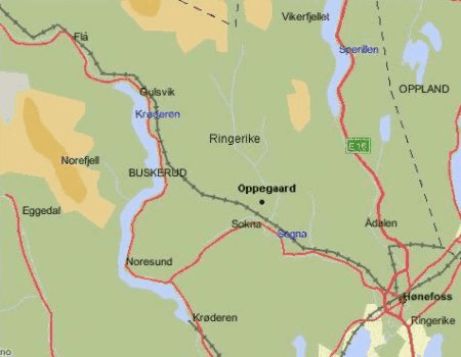
Sigurd was born in Gulsvik
in 1412 and died in 1482.
He married Eli Guttormsdatter Kirkeberg
and they had three children: Guttorm Sigurdsen, about
1430; Torgund Sigurdsdatter and Erlend Sigurdsen til Trommald. Eli
died in 1475 and Sigurd
re-married twice. We do
not know the name
of the second wife, but the
third was Un or Unna Vebjørnsdatter.
After Sigurd’s death in 1482,
Guttorm became the owner of
the Gulsvik property.
Before his death in 1511,
Guttorm had four sons: Helge,
Gunnar, Fredrik, and Thorgeir,
and a daughter, Torgun.
Helge married Ingrid Monsdatter Rud. They had nine children–five sons and four daughters. The
fourth son was Jon Helgesen Gulsvik, born at Gulsvik in 1520. Helge died some time after 1563
and Ingrid died 1594. A letter states her sons "acted in a Christian and affectionate manner toward
her after she became a widow."
The Gulsvik farm during Helge’s ownership included about 10,000 acres; it was one of the largest
in Flå but was divided after his death. The upper farm went to son Jon who acquired many
additional farms including the one known as Oppegaard, near Sokna about 20 miles away. Erling
Bjørke speculates that Jon got Oppegaard with his first wife, Tarand Halvorsdattter, as part of her
dowry.
Oppegaard and Sokna are about 15 miles southeast of Gulsvik and 35 miles northwest of Oslo, in
the area known as Ringerike. (We traveled on the train through the area during one of our trips to
Norway. The terrain is hilly to mountainous and is mostly forested.)
The name Oppegaard first appears in a letter of 1524 in which it is written "Opgordhin i Soknedal." In
1574, the name is written Oppegardt. The spelling Oppegaard first appears in 1604.
Oppegaard has long been one of the largest estates in the area once totaling 6,300 acres. It is now
divided into three farms: Lower Oppegaard has about 3,070 acres of which 3,000 is woodland, 50
acres are cultivated and 20 acres are tillable but uncultivated; Upper Oppegaard I, commonly
called Ree or Re, has 3,000 acres woodland, 20 acres tilled and 2 acres untilled but tillable. Upper
Oppegaard II has 162 acres of woodland, 14 acres tilled and 2 acres untilled but tillable.
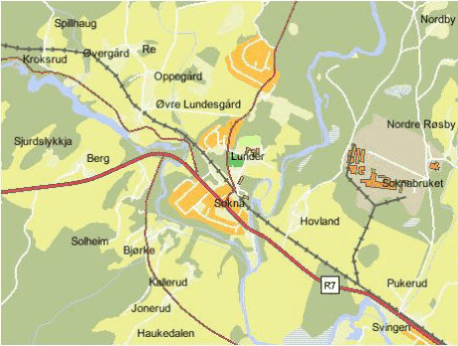
Until about 1880, the owners of Oppegaard were also part owners of another nearby wooded area
of 5,000 acres called Solskinskogen or Sunshine Forest.
For more on types and names of Norwegian farms and farmers, see Husman and bonde.
Jon Helgesen Gulsvik and Tarand Halvorsdatter had a son Guttorm about 1561 and a daughter Olaug
about 1562. Tarand died that same year, possibly as a result of Olaug’s birth. Jon
re-married Åse Paulsdatter about 1563 and they had six children: three girls, then three boys. The
name of the oldest son was Helge Jonsen, born about 1570. The seond was Klemet Jonsen, born
about 1575.
After Jon's death in 1591, the surviving family members argued over the division of the estate. An
agreement reached in 1609 provided that Klemet, then about 34, be given property in Oppegaard
near Lunder and Sokna. However, the actual division of the estate was delayed another 14 years
or so and a final settlement was not worked out until 1632.
But Klemet had died sometime prior to 1630, before he could take possession of his inheritance.
Although he may never have lived at Oppegaard, he was known when he died as Klemet Jonsen
Oppegaard, the first member of the family to carry that name–or address.
Near the beginning of the dispute over Jon's estate, Klemet married a woman whose name is not
known and had five children with her including Elling Klemetsen, born about 1604.
Elling, who lived to be 92 years old, became very rich. He ended up owning all of Oppegaard,
plus two other estates called East-Veme and Hovland.
Elling was married twice--first to Inger Andersdatter, with whom he had seven children. The
oldest was Helge Ellingsen Oppegaard or Berg (see map), born in 1629.
We don't know when Inger died, but sometime in the 1680s, probably, Elling married Gunhild
Fredericksdatter. She was born in 1667 and thus was in her late teens while her bridegroom was
about 80. With her he had two daughters, Inger, born in 1686, and Barbo, born in 1688 when
Elling was 84. Elling died January 25, 1696, at the age of 92. Gunhild died January 26, 1741,
at about 73.
After Elling's death, Oppegaard was divided among his nine children; but Helge acquired the
shares of the others except for a small portion assigned to Gunhild, his stepmother. Some siblings
did not give up their shares willingly. Helge had to sue his brother Povel (Paul) to get his portion.
In the 1660s, Helge bought the Upper Berg estate in nearby Lunder and lived there. For that
reason he was sometimes called Berg.
Helge was often in trouble. He was convicted and fined for illegal moose hunting. Another time
he and two other men were arrested for allegedly assaulting some Finns who were hunting, taking
away their clothing and forcing them to walk home to Borgerud, three to four hours away, in their
shirts; the Finns claimed they had permission to hunt. Helge was also once arrested for being
drunk in church.
He married Ronnaug Eriksdatter Slevika from Krodsherad (born in 1637) and they had nine
children. Their first was Povl Helgesen, born in 1663
Helge died in 1711 at the age of 82. Ronnaug died July 14, 1714, at 77.
Povl married Berte Jonsdatter Lower Berg, who was born in 1663 and died March 30, 1738. Povl
died January 7, 1748, at the age of 85.
Of their seven children, the oldest was Erik Povlsen Oppegaard or Viker, born in 1686.
In 1731, Povl and Berte divided their property among their children, giving Erik ownership of
one-fourth of Oppegaard and a leasehold on two-thirds. Not content with that, Erik purchased
some of his siblings' land and eventually owned four-fifths of Oppegaard.
Erik married a widow, Ingeborg Nilsdatter Viker March 22, 1722, and thus acquired more land,
eventually owning parts of three estates in addition to Oppegaard. From the time of their
marriage, Erik and Ingeborg lived in Viker and were known by that name. They had three
children, the oldest being Paul Eriksen Viker, born August 22, 1722.
After Ingeborg died toward the end of the 1720s, Erik married Joran Gunvalsdatter Strande, the
sister of one of his sons-in-law.
After Erik's death October 21, 1742, Paul bought his mother's share of Lower Oppegaard and the
shares of the other children, owning all that his father had owned, plus Upper Oppegaard.
Paul Eriksen Oppegaard, as he was then known, married Mari Andersdatter from South Hval
or Semmes in Aadalen on October 10, 1744. She was baptized March 18, 1725, and buried July 1,
1806. They had ten children. The sixth child, and fourth male, was Anders Paulsen, baptized
October 27, 1759.
Paul died March 16, 1783 and after his death, the widow and children agreed to a division of the
estate without the intervention of a judge--an unusual occurrence, apparently, in those days.
It provided, among other things, that son Erik should get Lower Oppegaard and Anders should
get Upper Oppegaard. Erik and his wife had no children and when they died, after some dispute,
it was agreed that Anders should be allowed to buy Lower Oppegaard, which he did.
Anders Paulsen Oppegaard or Strande married Kari Nubsdatter Strande October 27, 1782.
She was born in 1760 and they had eight children. Kari had no brothers and since she was the
oldest daughter, Anders took over Strande, one of the largest estates in Aadalen. They must have
lived there since they took the name of Strande.
Anders died November 22, 1835 and Kari in the first half of 1843.
The second son was Nub Andersen Oppegaard or Strande baptized February, 1786. His first
wife was Ronnaug Iversdatter Åseth whom he married October 27, 1811. She was born in 1784
and died May 13, 1815, possibly of childbirth complications. They had a daughter, Kari, and a
son, Erik Nubsen Oppegaard, who was born May 10, 1815, three days before his mother's
death.
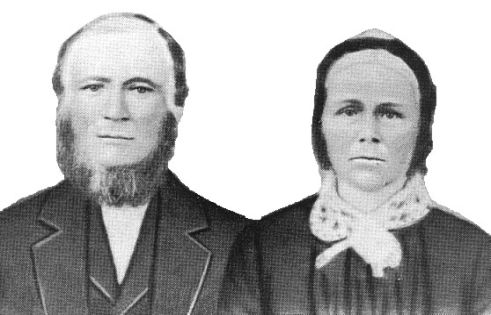 Erik and Guri Oppegaard
Erik and Guri Oppegaard
Erik Nubsen Oppegaard married Guri Christoffersdatter Garhammer. The dates of her birth and
their marriage are in dispute. Milo's history says she was born February 18, 1810 and they married
November 4, 1833. Another report shows her birth date as February 18, 1819 or 1820 and that
she and Erik married in November 1838. The latter seems more plausible.
They had eleven children:
Ronnaug January 9, 1839 November 4, 1839
Nub February 9, 1841 December 9, 1919
Kristian May 2, 1843
Maren November 29, 1844 1899
Anders December 15, 1846 January 5, 1868
Paul December 17, 1848 September 26, 1932
Edvard Carl April 13, 1851 January 22, 1921
Ronnaug January 2, 1854 January 3, 1854
Bernt Martin July 21, 1856
Inger Thorine January 3, 1859 January 14, 1930
Johannes May 10, 1861 September 24, 1904
In 1842, Erik purchased Oppegaard from Nub's second wife, his stepmother, Kari. Erik was once
considered the richest man in the county, but he speculated in timber and lost everything. As a
result, Oppegaard was sold at a forced sale in 1862 for 4550 specie dollars. Upper Oppegaard is
now owned by Ellef Kristian Berg, the grandson of one of those who bought it from Erik.
Another of Erik's farms, Tranby, was ordered sold in 1863.
The fallout from timber speculation was not over. In 1877 it pushed Anders Pederson Oppegaard
into bankruptcy and he was forced to sell Lower Oppegaard to his son Anton in 1890. But Anton
was also a speculator--not in timber, but in Oslo real estate. He, too, went bankrupt in the late
1890s and sold the farm to Torlief Bache of Drammen. But a brother and sister of Anton sued
Bache contending they owned the property by right of primogeniture. Bache, apparently believing
they would prevail in court, sold the farm back to Anton.
Anton died April 29, 1929. His wife was Olga Loken of Osterdalen; they had no children. On
December 4, 1933, she sold Oppegaard to Vilhelm Blystad, an Oslo factory owner and the
husband of Anton's sister Martha, for 200,000 kroner.
The owner, as of 1982, was Arne Blystad, the son of Vilhelm and Martha (Oppegaard).
Erling Bjørke visited the farm in 1982. He reported that the home built on Lower Oppegaard in
1680 had been restored in the 1960s. The log house on Upper Oppegaard, the birthplace of the
children of Erik Nubsen and Guri Oppegaard, was still standing.
So, the farm is still held in the family, but not in the male line as it had been for about 400 years.
Bjørke says no Oppegaards whose ancestry connects them to the farm are known to still live in
Norway.
After their loss of Oppegaard, Erik and Guri moved to Tranby. One of his grandsons said if Erik
had not gone bankrupt in the early 1860s, he and his family probably would never have left
Norway. But, within the decade they did.
But before then, they suffered another loss: the death of 21 year old son Anders in January of
1868.. We don’t know the cause.
Coming to America
It’s not clear which member of the family was first to leave for America. Milo says Nub, their
second oldest child and oldest son, was the first, emigrating in 1861. But other records indicate he
married Ann Olsdatter Kittlesbye in Norway in 1862 or 1863.
Paul indicates in his reminiscence that Nub was with him when he left Norway September 1, 1868,
but no mention is made of Ann.
Paul's is an excellent account of his settling in the United States which is
included on this site. See Paul Oppegaard’s story.
After a stop in England, Paul and Nub landed in Quebec September 17, and arrived on September
24, in Calmar, Iowa, in an area where many Norwegians had settled..
Raising a further question about who was first to immigrate, Paul suggests that Kristian had
arrived in Calmar some time earlier and arranged for Paul's first job of cutting wood.
Paul wrote that in the spring of the next year, 1869, he and Kristian bought tickets for passage to
America for their parents and siblings Bernt, Inger and Johannes. In the year before the latter five arrived,
Paul, then 20, married Maren Hansdatter Sandager, then 22, of Lunder, near the
Oppegaard home in Norway.
In 1870, six members of the family left for America. The first was Edvard Carl who departed from
Christiania (Oslo) on July 30 on the steamship Argo. His emigration record indicates his
destination was Prairie du Chien, Wisconsin. That’s not far from Calmar, Iowa, but there is no
indication whether he was in contact with Kristian and Paul.
In time, he may have moved to Otter Tail County, Minnesota, where he is listed as one of the
petitioners asking for the formation of Leaf Lake Township. Another signer was Erik O. Haukedahl,
possibly the brother of Peder O. Haukedal of whom more later.
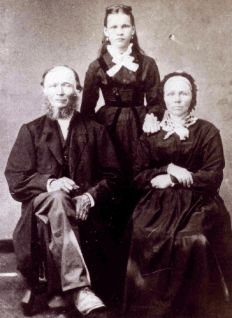 Erik, Inger and Guri Oppegaard
Erik, Inger and Guri Oppegaard
Erik, Guri, Bernt, Inger and Johannes crossed the Atlantic
about two months after Edvard Carl, departing from
Christiania on September 6,1870, on the steamship
Scotia. Their destination was Calmar where they joined
Kristian, Paul and his new wife Maren Sandager, who had
come to America with her parents and a sister, Gunhild,
in 1854.
At that time, Erik was about 55 years old, Guri was 60
(or 51), Bernt was 14, Inger 11 and Johannes 8.
In 1872, Paul and Maren, Kristian, the parents, Bernt,
Inger and Johannes decided to move to Twin Lakes in
Freeborn County, Minnesota.
Erik, Guri and the children had been living in a house near
Calmar. When they left, they tore down the house, hauled
the lumber into Calmar, rebuilt the house and sold it.
Driving twelve head of cattle, the journey to Twin Lakes took seven days. They arrived May 31,
1872.
Paul and Maren, who became known as Maria, settled there and had 13 children. They moved
briefly to northern Minnesota and to Snohomish, Washington, but returned each time to Freeborn
County. Paul died in 1932 and Maria in 1935. Rev. Lodver Scheie assisted at Maria’s funeral.
Both Paul and Maria are buried at Lunder Church near Twin Lakes.
It was perhaps in Calmar that Inger Thorine met or, more likely, re-met Peder Olsen Haukedalen
who, like she, had come from a farm near Oppegaard in Ringerike 1868. They were married at
Erskine, Minnesota, on June 24, 1877. She was 18; he was 30.
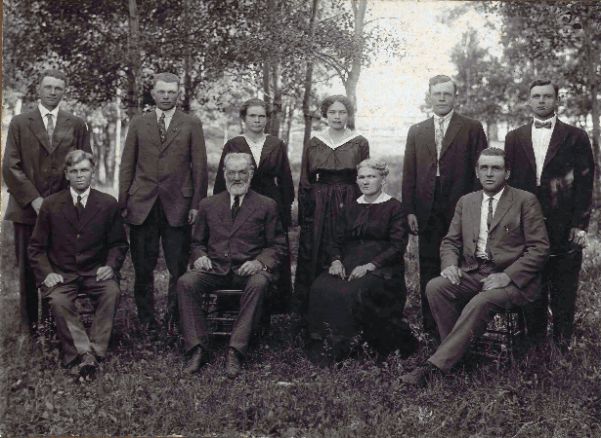 The Haukedals: (Back row) Joseph, Albert, Ida, Amelia (Millie), Oscar.
The Haukedals: (Back row) Joseph, Albert, Ida, Amelia (Millie), Oscar.(Front row) Ingvald, Peder, Inger Thorine, Edgar
They homesteaded in Columbia Township, Polk County, in 1890 and remained there until 1895
when they moved to Alberta, Canada. They had ten children and most of the family remained in
Canada.
At some point, Nub had parted ways with Paul and Kristian in Calmar and had moved, with wife
Ann, to near Henning in Otter Tail County, Minnesota, where Edvard Carl also moved. They
remained there until 1897 when Nub went back to Norway and fathered a daughter, Martha Emilie
Nubsdatter Evjua, with Kirstine Ellingsdatter Bjarnaas/Evjua.
He returned to the U. S., divorced Ann, left again for Norway and married Kirstine on May 13, 1904.
They had two more children: Nordal Karl, born 1905; and Aagot, born 1907. Nub died in Buskerud,
Norway, on December 9, 1919.
Sometime after 1872, Erik, Guri and the family moved from Twin Lakes to Fox Lake in Rice
County, Minnesota, where son Kristian had a farm. While they were there, daughter Maren arrived from
Norway, the last member of the family to immigrate. Although we don’t know that
the family moved, Guri died and was buried at Henning, where Nub and family lived, in 1881 after
stepping on a nail and developing blood poisoning.
In 1883, Erik, along with Maren, Bernt and Johannes, moved north to Polk County, Minnesota,
where 13 townships had been opened to homesteading. Erik, John, Bernt, and Paul acquired adjoining
quarters just southeast of Erskine. Erik’s was the southeast quarter of section eleven which was acquired
by Bernt after Erik’s death in 1897
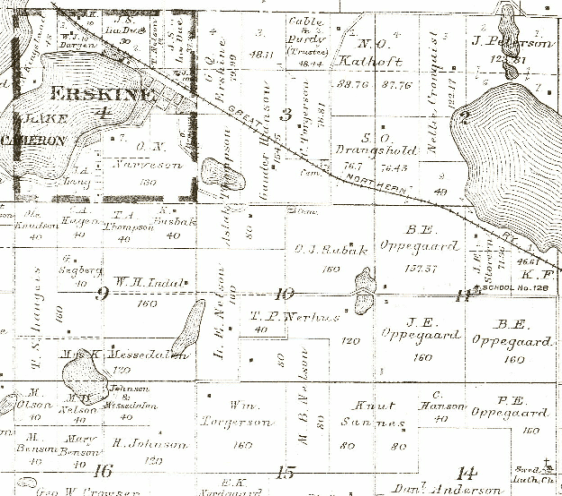 1902 plat
1902 plat
About two miles east is a quarter owned by “E. Oppegaard” next to Oppegaard Lake, a middle-sized pond
now. That could have been Erik’s land or it could have been Edvard’s.
A mile northeast is the Husby homestead, occupied later by Peter and Olga Husby, then by Toots and
husband Leo Johnson. And a mile to the southwest is the quarter of J. J. Vaatveit whose great
granddaughter Jean married Harold Husby.
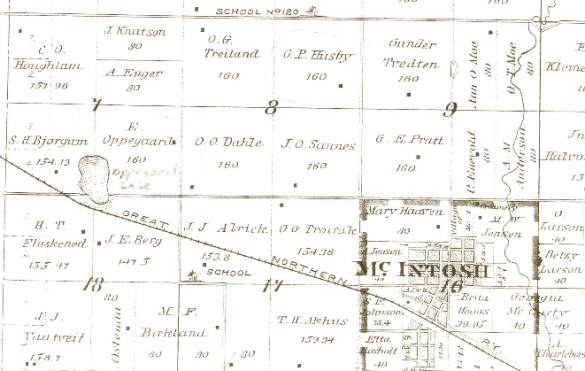
.jpg) Maren Oppegaard
Maren OppegaardMaren married Andrew Norling, a native of Sweden on April 5,
1886, when she was 41 and he was 35. Their land was in
Columbia township.
They had no children. She died in Pollk county in 1899 at age
55. He died in 1940 at 89.
We do not know when, but eventually Edvard Carl also settled in
Polk County, near McIntosh. He married Karen Uggen and they
had eleven children. Many of their descendants live there today.
Erik remained in the area for the rest of his life. His grandson,
Paul E. Oppegaard, writes that he visited Erik in McIntosh in
1896. Erik was then living with son Bernt, had been bedridden
for a long time, was helpless and nearly blind. He died
December 21, 1897 of “old age” and is buried in a cemetery
near his homestead.
Johannes in Polk County
Four years after settling on his homestead, on March 5,1887, John as he was then known, married
Rosine Marie Hanson. She was 20 at the time, born December 18, 1866, in Wisconsin, the
daughter of Gunder and Marie Hanson, emigres from Norway. Polk county records show her
name as Rosine Marie Gunderson.
John and Rosine had three children: Emil Gottried, born December 12, 1887; Georgine (Gina),
born July 5, 1889; and Goodwin John, born May 8, 1891. The parents apparently had a hard time
deciding on Goodwin's name; he was still unnamed when his birth was registered June 5.
Two years later, on July 7, 1893, Rosine died at the age of 26 of what the death record says was
"quick consumption." She is buried in the nearby Lutheran Pioneer Cemetery.
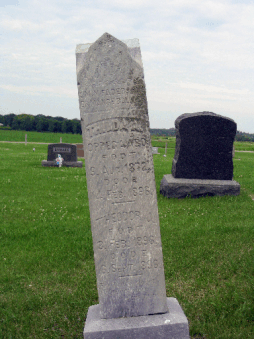
Two years later, on May 10, 1895, John married Thilda A. Thompson who was 22 years old, born August 9, 1872, in Norway. On February 3, 1896, she gave birth to a son, Theodor Johannes. Just eleven days later, Thilda died of the death certificate called "porperal fever following confinement." It was surely puerperal fever or childbed fever, a then-common infection of female reproductive organs after giving birth
Theodore died seven months after that, on September 8, in the family's home of "colera infantium" or cholera infantum, a common diarrhea affecting young children. Pepto-Bismol was developed specifically to combat it.
The Crookston Times reported “The infant child of (County) Cmr. Oppegaard, aged seven months, died at
the family residence yesterday, the sad intelligence being conveyed to Mr. Oppegaard while he was here
attending to his official duty.”
Thilda and Theodor are buried side by side in the Synod Cemetery
southeast of Erskine in the Thompson family plot.
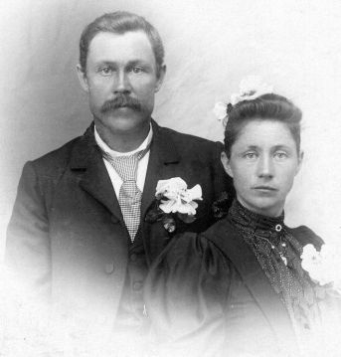 John and Dorthea Oppegaard
John and Dorthea Oppegaard
On July 16 of the following year, 1897, John married for a third time–to Dorthea Olson or Messelt or Mykleby. She had been born in Osterdalen, Norway, in May of 1867 and was a widow, having been married previously for two years to Edwin Messelt of the Winger area. They were married in McIntosh by Rev. Kristofer Dalager who was also pastor of the Erskine church where John was a member.
(See Mykleby family history)
The next year, Dorthea gave birth to Dagny Juliane on August 27, 1898-- and on March 13, 1900, to Ellen Rosine. Giving Ellen the second name Rosine, after John's late first wife, followed a somewhat modified Norwegian custom.
(SeeAppendix C, last paragraph.)
During these years, John was involved not only in farming and raising a family, but also in civic
affairs. By 1900, he had served as chairman of the town board, town clerk (of Knute Township,
perhaps), school district clerk and, as noted earlier, county commissioner.
In 1900, at age 39, John was elected to the Minnesota legislature on the Populist ticket.
The Populists were an agrarian reform party which favored switching to
silver-backed currency as an inflationary strategy to increase the incomes of
farmers. They felt banks, railroads and the Eastern corporate establishment--the
"robber barons"--were exploiting them. The Populists' major national figure was
William Jennings Bryan; in Minnesota, Ignatius Donnelly was a leader.
Minnesota, however, was a strongly Republican state. Of the 117 state legislative
representatives elected in 1900, 94 were Republicans, 14 were Democrats and 6
were Populists. But the Populists dominated northwestern Minnesota, electing six
of the area's nine representatives.
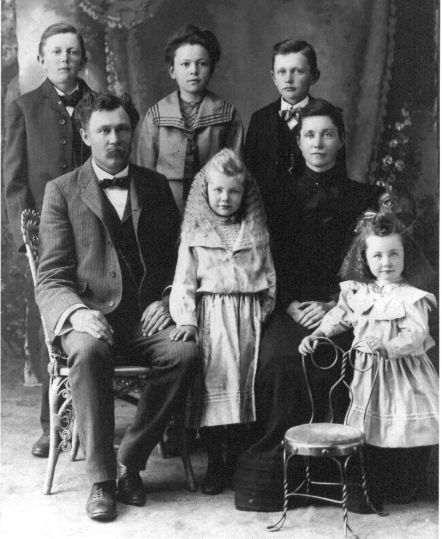 Emil, John, Georgine, Dagny, Goodwin, Dorthea and Ellen Oppegaard
Emil, John, Georgine, Dagny, Goodwin, Dorthea and Ellen Oppegaard
Polk county already had one Populist representative, James Cumming, a farmer near Mallory in the
western end of that large county.
The Populist ticket, including Oppegaard and Cumming, was endorsed by the Crookston Times in
its pre-election issue of November 3, 1900. The Times said Oppegaard had "served the people of
Polk county in various capacities and has always proven himself worthy of the confidence reposed
in him. As a member of the county board Mr. Oppegaard was a diligent, careful and conscientious
worker, giving the closest attention to every detail...as if he were conducting his own matters.
Mr. Oppegaard's neighbors are his most enthusiastic supporters, and in all his long residence in the
county his honesty and ability have always been recognized."
In the November election for two legislative seats, the two Populists outpolled the two
Republicans: Cumming got 2891 votes, Oppegaard 2598, Opheim 2245 and Krostue 2249.
John served just one term in St. Paul and did not seek re-election in 2004. One reason may have
been that he was suffering from gall stones.
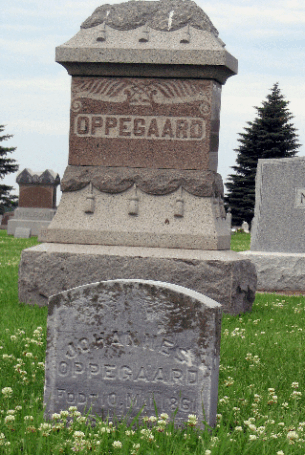
On September 23, 1904, John died of
complications following gall bladder surgery at
Bethesda Hospital in Crookston..
Both the Crookston Times and Erskine Echo
reported his death in laudatory articles.
The Echo said he “was one of the old residents
of the county and was well liked and respected
by all who knew him. He was a strong
workers for the cause of temperance and christianity...”
His funeral was held at the United church in
Erskine and, according to the Echo, “the
remains were followed to their last resting
place by a very long procession of sorrowing
relatives and friends.”
He was buried in Fairview Cemetery southeast
of Erskine where many other Oppegaards are
buried.
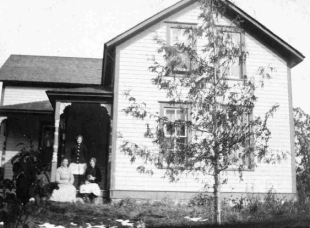 The Oppegaard farmhouse
The Oppegaard farmhouseDorthea and the five children--aged 4 to 17--stayed on the farm for awhile, but within a few years moved to McIntosh. We know very little of those years.
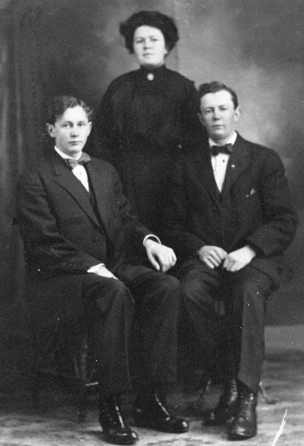 Goodwin, Georgine, and Emil Oppegaard
Goodwin, Georgine, and Emil OppegaardThe oldest child, Emil, had some kind of
mental disability. Parnell Oppegaard described
him as simple and eccentric and one who
“heard voices.” He said Emil farmed in the
area in the 1920s and 1930s, but lost the farm
when he deep-plowed bringing to the surface
heavy clay in which crops would not grow..
At some point he was institutionalized.
I have a faint memory of visiting him with my
parents at a state hospital in Fergus Falls,
probably in the 1930s. Eventually he returned
to McIntosh where he spent his remaining
days at the Pioneer Home and died September
24, 1971 and his buried next to his father,
John, in Fairview Cemetery.
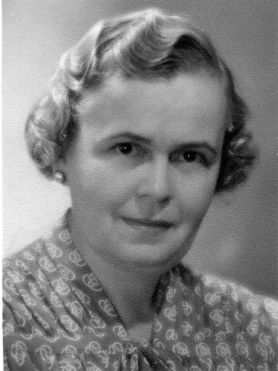 Georgine Oppegaard Alarik
Georgine Oppegaard Alarik
Georgine, called Gina, married Hilding Alarik
who, grandson Richard Neely reports, became
advertising manager for the Hearst newspapers.
His work required much travel and the family
frequently relocated. They lived in Des Moines
and Cleveland and other places before settling in
Minneapolis, first on Humboldt at about 35th
Street and later in the 33 hundred block of Dupont.
Gina was a most capable, warm person--a very
active member of Central Lutheran Church. She
and Hilding had four children.
 Georgine Alarik and children
Georgine Alarik and children
Ruth was born July 18, 1912. She married August Luckemeyer of St. Cloud (born July 15, 1912) and they had three children: John Kent, Georgi Ann and Laurie Jean. Augie died in August of 1952. Ruth and her children settled in northern California. In her final years, she lived close to Georgi Ann (Gigi) in Rocklin. Ruth died May 18, 2002. She was a most warm and gracious person like her mother and we corresponded occasionally.
Janet was born February 24, 1914. She was an artist who studied at the Minneapolis Institute of
Art and was one of the first students I knew to study in Italy. She married Robert Neely.
Janet and Robert had an interesting life which Richard Neely has described in a perceptive essay. See
Goodwin, known as Buddy or Bud, was born May 19, 1916. He attended the University of
Minnesota and worked for the Foote, Cone & Belding advertising agency and for Hallmark Cards
in Kansas City.
 The Alariks: George, Ruth, Gina, Goodwin, Janet
The Alariks: George, Ruth, Gina, Goodwin, Janet
George, born March 13, 1919, also attended
Minnesota and worked in advertising. When
we lived in Minneapolis in 1952, he was with
the Campbell Mithun agency and helped
Marge get a job there in the first year we
were married. He was a notably amiable and
friendly man. He later was advertising
manager for the Minnesota & Ontario Paper
Company.
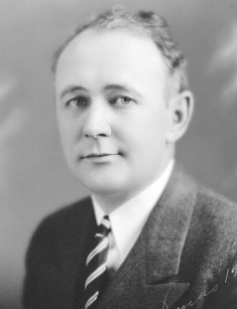 Goodwin Oppegaard in 1951
Goodwin Oppegaard in 1951
Goodwin Oppegaard served in the army in World War I. He attended law school, then practiced in Beach, North Dakota, and Los Angeles before taking a position with the Federal Deposit Insurance Corporation in Washington where he remained for the rest of his career. He and his wife Hazel had no children.
Goodwin died March 11, 1963. Hazel passed away October 14, 1973.
Both are buried at Fort Rosencrans National Cemetery, Point Loma, San Diego County, California.
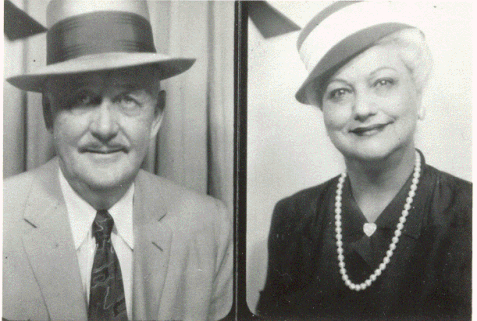 Goodwin and Hazel Oppegaard
Goodwin and Hazel Oppegaard
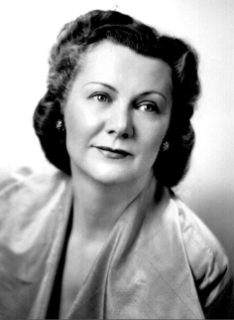 Dagny Conger
Dagny Conger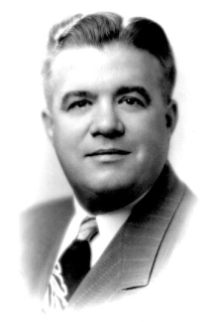 Bill Conger
Bill Conger
Dagny married William Conger who was in the wholesale lumber business. He traveled a lot--to lumber
mills in northern Minnesota and to lumber yards in the southern part of the state.
Dagny was the glamorous member of the family--tall and slim, well-dressed, hair dyed slightly red.
She tended to rule her family, especially the easy-going, cigar-smoking Bill who seemed to worship
her.
They had one child, Jean Catherine, born in February 8, 1929--six weeks after I was born.
I remember their living in an apartment at the northwest corner of Garfield and 33rd Street, across
from a water station, then in houses at 5008 Abbott and 4333 Beard. In the mid-1940s, they built
on Edgebrook in Edina, just across Minnehaha Creek from 50th Street.
They belonged to Plymouth Congregational Church but didn't seem to be especially active. Jean
and I were good friends. She and her folks didn't often come to Joice, but we frequently visited
Minneapolis where Dad's mother and sisters also lived and where he had church conventions and
other meetings.
Jean read a lot and recommended books to me; I remember the Raggedy Ann and Oz and H. Allen
Smith books in particular. She used words like tragedian and she would write plays which we
would put on for our parents. My creative contribution, other than acting, was devising a curtain
which we could open and shut in front of the stage. She thought that was very clever.
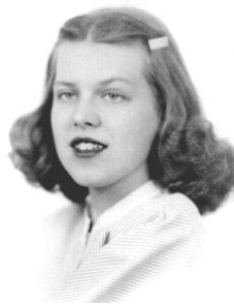 Jean Conger
Jean Conger
When she was 16, Jean was found to have a brain tumor.
Surgeons in Rochester removed it, but in the process her
hearing was lost.
Despite her deafness, Jean went on to college. She took
courses at St. Catherine's College in St. Paul, showing
she could do it, then went to the school she had long
wanted to attend: Mt. Holyoke in South Hadley,
Massachusetts, one of the Seven Sisters, from which she
graduated.
On April 8, 1952, Bill died suddenly of a heart attack. Ellen, who was then suffering from
depression and happened to be there at the time, leaped in to help in this crisis, her own problems
seemingly forgotten. Bill was buried at Lakewood Cemetery on a knoll overlooking Dupont
Avenue.
Soon, Dagny and Jean moved to California where they remained for the rest of their lives. They
lived mostly in the San Francisco area, but also for a time in or near Long Beach. I'd occasionally
hear from or about Jean and once received from her a book she had written: "Cats."
Jean died on July 26, 1963. I understood that the tumors that taken her hearing had continued to
sprout up. Her funeral was held in Minneapolis and I was one of the pall bearers. She was buried
next to her dad at Lakewood.
Dagny returned to San Francisco where Marge and I visited her in her apartment near the Pacific in
the 1970s. She was most gracious.
Gigi wrote me in 1988, that she had had many fun years with Dagny both in San Francisco and
Long Beach. She and Ruth would lunch and shop with Dagny and she'd take her to the grocery
store and hairdresser every week.
She wrote, "Dagny has always been a contented homebody and used to sew beautifully and remake
clothes she'd buy on sale."
About 1985, Dagny broke her ankle and could no longer care for herself. Gigi arranged for moving
her to a nursing home, CareWestSierra Convalescent Hospital, in a town near Placerville. (The
letter indicated she broke her ankle in 1985, but Gigi said "she has lived at the same home since
December 1984?) By 1988, she could no longer feed herself and often didn't recognize Gigi who
said she visited her every other day after work.
Dagny lingered for another ten years, passing away August 16, 1998, eleven days short of 100
years.
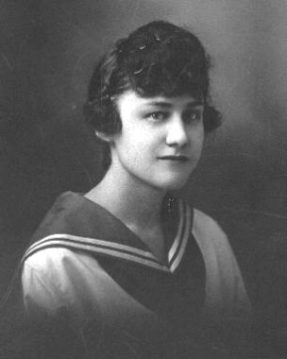 Ellen Oppegaard in 1918
Ellen Oppegaard in 1918
After the death of her father, John Oppegaard,
Ellen and the family stayed on the farm for
awhile, then moved into McIntosh.
Ellen graduated from high school, then took a
commercial course and worked in Minneapolis.
On June 7, 1927, she married Lodver Scheie.
For more on her later life, see Scheie family history.